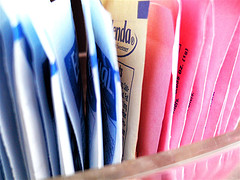 |
| Blue, pink, yellow? d) None of the above |
Yesterday, The New York Times ran a story entitled “Choosing a Sugar Substitute”. I found the article, like most sweeteners, unsatisfying. We’re told “for any of the sweeteners, one can as easily find a study that offers reassuring analysis of safety as one that enumerates potential alarming side effects.” When it comes to food and nutrition this “jury is still out” reasoning doesn’t work. As far as I’m concerned, the risky results have more clout. The article further tries to ameliorate potential risk by quoting a layperson and self-described “yellow girl” (yellow referring to Splenda affection) saying “hundreds of millions of people swallow food and drinks containing artificial sweeteners and so far, no widespread calamities of health have swept over them. “ I would love to know if yellow girl feels migraines, obesity and cancer are “widespread” enough. I don’t know if she equates danger with immediate death but we’re not talking about snake bites. With toxins, things can take time. Walter Willet expressed “if you smoke cigarettes, the lung cancer risk doesn’t go up for 30 years.” Trans fats weren’t seen as problematic for 90 years. You can read my thoughts on artificial sweeteners here in “Better Safe Than Sweet”
The best way to test a sweetener isn’t always research, where funding can introduce its own bias, but time. Sugar has been used long enough that we know the downside and concerns. Stevia has also been used for centuries in many cultures though only marketed (and approved) in the US recently. I was disappointed the Times article snubbed stevia. It is a plant you can grow in your garden. Detractors will say, “Just because it’s natural doesn’t mean it’s safe” and this is true but I’ll still take the garden over the lab as a starting point. I love a brand called NuNaturals, which has no stevia-y aftertaste but also have this local honey and maple syrup in my home. Liquid stevia can seems rather pricy but a small bottle can last months, even a year because it’s much sweeter than sugar. Since it’s much sweeter than sugar, you use it sparingly.
Even the title of the Times piece rubbed me the wrong way. Sweeteners aren’t mandatory. Whether it’s honey or maple or stevia, I don’t believe our food should be doused with sweetness. Sweet begets sweet and the more you have the more you crave. The converse is also true and less sweetness leads to fewer cravings. One “sweetened” item a day is a good guideline. For me, that tends to be my smoothie or an afternoon cardamom cappuccino. So I’m not a blue, pink or yellow girl and truthfully I’m not that sweet.
What sweetener(s) do you use? How many sweetened foods would you estimate you have each day? Have you tried stevia?

